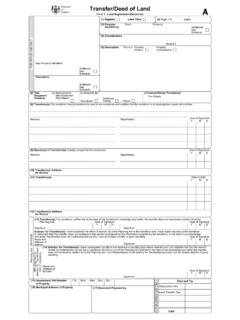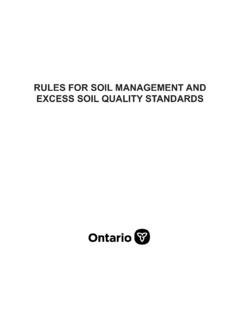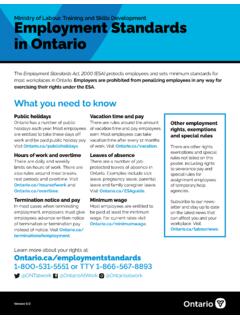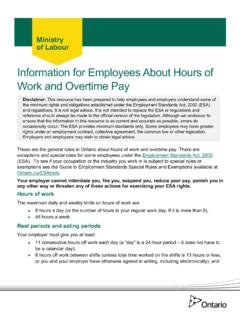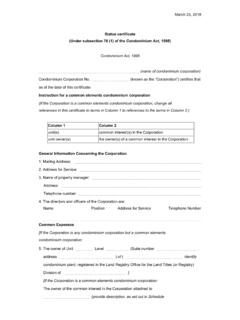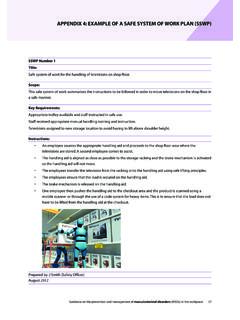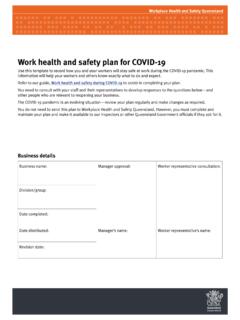Transcription of Health and Safety Guidelines
1 Ministry of Labour Revised September 2016. Health and Safety Guidelines workplace Violence and Harassment: Understanding the Law This Guideline and other resources relating to occupational Health and Safety may be viewed at the Ministry of Labour website ( ). A printed copy of this publication can be ordered: Online from ServiceOntario publications ( );. By phone through the ServiceOntario Contact Centre Monday to Friday, 8:30 am to 5:00 pm 416 326-5300. 416 325-3408 (TTY). 1 800 668-9938 Toll-free across Canada 1 800 268-7095 TTY Toll-free across Canada ISBN 978-1-4606-8518-1 (Print). ISBN 978-1-4606-8520-4 (PDF). ISBN 978-1-4606-8519-8 (HTML). Aussi disponible en fran ais. Copyright Queen's Printer for Ontario, 2016. Contents About This Guide 3. Introduction 4. Background 5. Key Terms and Concepts 6. workplace 6. Worker 6. workplace Violence 6. Domestic Violence 8. workplace Harassment 8. workplace Sexual Harassment 9.
2 Continuum of Behaviours 11. 2 workplace Violence 12. General Duties of workplace Parties 12. workplace Violence Policy 12. Assessing the Risks of workplace Violence 13. workplace Violence Program 16. Information and Instruction on workplace Violence 18. Information about a Person with a History of Violent Behaviour 19. Domestic Violence 21. Work Refusals 23. Notices 25. 3 workplace Harassment 26. workplace Harassment Policy 26. workplace Harassment Program 27. Investigating Incidents and Complaints 29. Results of an Investigation 33. Review of workplace Harassment Program 35. Information and Instruction on workplace Harassment 35. Inspector's Order 36. 4 Roles and Responsibilities 38. Joint Health and Safety Committees / Health and Safety Representatives 38. Ministry of Labour 39. Police 40. Ontario Human Rights System 40. Health and Safety System Partners 42. 5 Sample workplace Violence Policy 43.
3 6 Examples of Measures and Procedures for workplace Violence Programs 44. 7 Sample workplace Harassment Policy 47. 8 Sample workplace Harassment Program 48. 9 Ministry of Labour Contact Information 53. 2 workplace Violence and Harassment: Understanding the Law About This Guide This guide explains what every worker, supervisor, employer and constructor needs to know about workplace violence and workplace harassment requirements in the Occupational Health and Safety Act. It describes everyone's rights and responsibilities, and answers in plain language the questions that are most commonly asked about these requirements. Please note this guide does not constitute legal advice. It should not be taken as a statement of the law or what constitutes compliance with the law. If you need help in determining what constitutes compliance, you should consult a lawyer. This guide does not cover every situation or answer every question about the legal requirements for workplace violence and workplace harassment in Ontario.
4 It also does not cover requirements for other workplace Health and Safety issues. You should consult A Guide to the Occupational Health and Safety Act for information about other requirements, which is available on the Ministry of Labour website This guide does not cover other legal obligations that may exist such as those under Canada's Criminal Code or Ontario's Human Rights Code. Ontario Ministry of Labour Health and Safety inspectors enforce the Occupational Health and Safety Act and may refer to this guide when determining compliance. They do not enforce this guide. Ministry of Labour inspectors will apply and enforce the OHSA and its regulations based on the facts as they may find them in the workplace . This guide does not affect their enforcement discretion in any way. The ministry has produced other resources in addition to this guide, including a Code of Practice for workplace Harassment, which can be used to help workplaces comply with the workplace violence and workplace harassment requirements in the Occupational Health and Safety Act.
5 For more information, please see the Ontario Ministry of Labour website ( ). workplace Violence and Harassment: Understanding the Law 3. Introduction Ontario's Occupational Health and Safety Act 1 sets out the rights and duties for occupational Health and Safety of all parties in the workplace . The act provides for enforcement of the law in cases where compliance has not been voluntarily achieved. The requirements for violence and harassment in the workplace establish minimum standards and set out the rights and duties of all those who have a role in dealing with workplace violence and workplace harassment. One of the primary purposes of the Occupational Health and Safety Act is to facilitate a strong Internal Responsibility System (IRS) in the workplace . The IRS means that everyone in the workplace has a role to play in keeping workplaces safe and healthy. Workers in the workplace who see a Health and Safety problem such as a hazard or contravention of the Act in the workplace have a duty to report the situation to the employer or a supervisor.
6 Employers and supervisors are, in turn, required to address those situations. The employer, typically represented by senior management, has the greatest responsibilities with respect to Health and Safety in the workplace . The employer is responsible for ensuring that the IRS is established, promoted, and that it functions successfully. A strong IRS is an important element of a strong Health and Safety culture in a workplace . Every improvement in occupational Health and Safety benefits all of us. Through co-operation and commitment, we can make Ontario a safer and healthier place in which to work. 1 The Occupational Health and Safety Act is amended from time to time. A current version is available from the e-Laws website ( ). 4 workplace Violence and Harassment: Understanding the Law Background Workers may face violence and harassment in any workplace and from any person in that workplace . There is a continuum of unwanted behaviours that can occur in a workplace .
7 This can range from offensive remarks to violence. It is important for employers to address any unwanted behaviours early to minimize the potential for workplace harassment to lead to workplace violence. Employers, therefore, have specific duties with respect to workplace harassment and workplace violence under the Occupational Health and Safety Act. The harassing or violent person may be someone the worker comes into contact with due to the nature of his or her work. This may include, but is not limited to, a client, customer, volunteer, student, patient, etc. The harassing or violent person may also be part of the workforce, including a co- worker, manager, supervisor or employer. Or the person may be someone with no formal connection to the workplace such as a stranger or a domestic/intimate partner who brings violence or harassment into the workplace . Canada's Criminal Code deals with matters such as violent acts, sexual assault, threats and behaviours such as stalking.
8 The police should be contacted in these situations. Harassment may also be a matter that falls under Ontario's Human Rights Code. workplace Violence and Harassment: Understanding the Law 5. Key Terms and Concepts workplace The Occupational Health and Safety Act defines a workplace 2 as any land, premises, location or thing at, upon, in or near which a worker works [section 1]. A workplace could be a building, mine, construction site, vehicle, open field, road or forest. Worker Worker means any of the following, but does not include an inmate of a correctional institution or like institution or facility who participates inside the institution or facility in a work project or rehabilitation program: 1. A person who performs work or supplies services for monetary compensation. 2. A secondary school student who performs work or supplies services for no monetary compensation under a work experience program authorized by the school board that operates the school in which the student is enrolled.
9 3. A person who performs work or supplies services for no monetary compensation under a program approved by a college of applied arts and technology, university or other post-secondary institution. 4. A person who receives training from an employer, but who, under the Employment Standards Act, 2000, is not an employee for the purposes of that Act because the conditions set out in subsection 1 (2) of that Act have been met. 5. Such other persons as may be prescribed who perform work or supply services to an employer for no monetary compensation. workplace Violence The Occupational Health and Safety Act defines workplace violence as the exercise of physical force by a person against a worker, in a workplace , that causes or could cause physical injury to the worker. It also includes an: 2 The term workplace may be interpreted differently under other Ontario statutes such as Ontario's Human Rights Code and workplace Safety and Insurance Act, 1997.
10 6 workplace Violence and Harassment: Understanding the Law attempt to exercise physical force against a worker in a workplace , that could cause physical injury to the worker; and a statement or behaviour that a worker could reasonably interpret as a threat to exercise physical force against the worker, in a workplace , that could cause physical injury to the worker [section 1]. This may include: verbally threatening to attack a worker;. leaving threatening notes at or sending threatening e-mails to a workplace ;. shaking a fist in a worker's face;. wielding a weapon at work;. hitting or trying to hit a worker;. throwing an object at a worker;. sexual violence against a worker;. kicking an object the worker is standing on, such as a ladder; or trying to run down a worker using a vehicle or equipment such as a forklift. The definition of workplace violence is broad enough to include acts that would constitute offences under Canada's Criminal Code.

